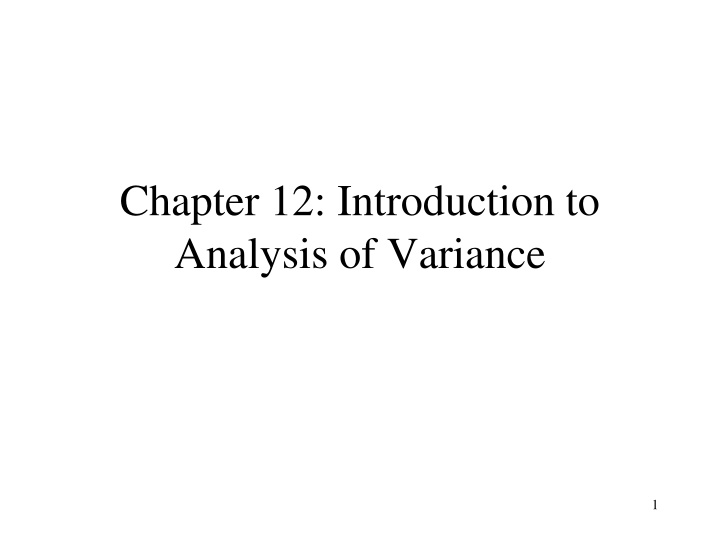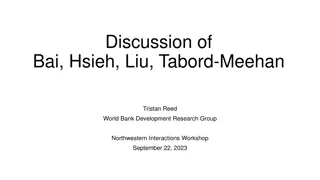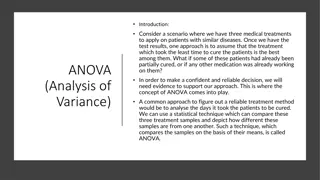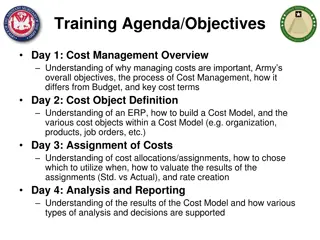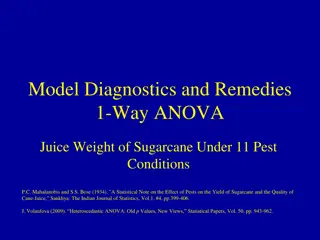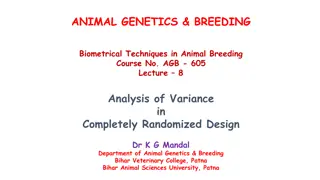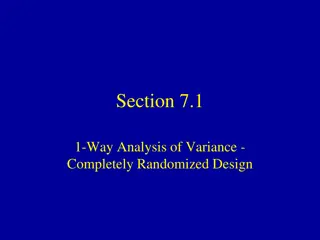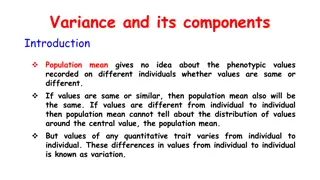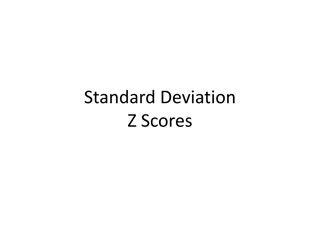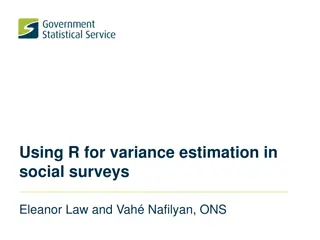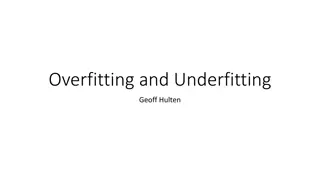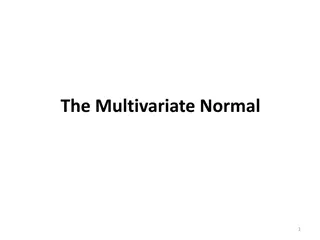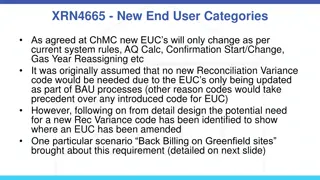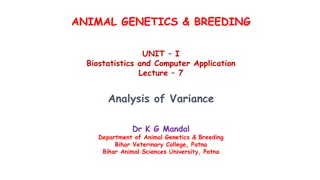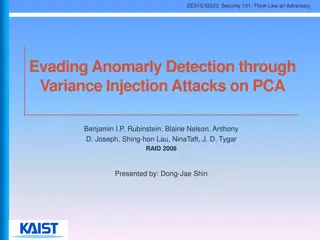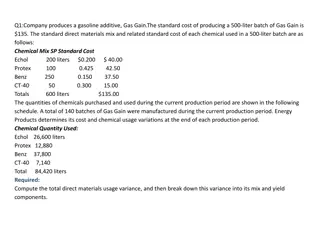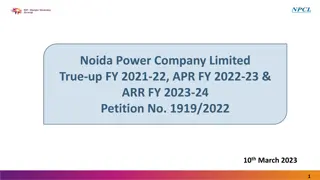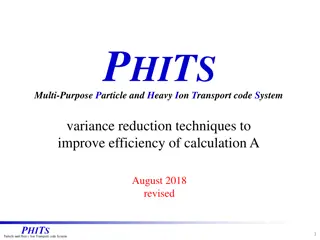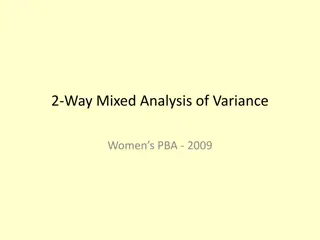Introduction to Analysis of Variance
This content covers a detailed explanation of Analysis of Variance (ANOVA), including statistical hypothesis, treatment effects, variability within and between treatments, variance calculations, and temperature conditions analysis. It explores the different factors impacting variance in experimental data.
Download Presentation

Please find below an Image/Link to download the presentation.
The content on the website is provided AS IS for your information and personal use only. It may not be sold, licensed, or shared on other websites without obtaining consent from the author.If you encounter any issues during the download, it is possible that the publisher has removed the file from their server.
You are allowed to download the files provided on this website for personal or commercial use, subject to the condition that they are used lawfully. All files are the property of their respective owners.
The content on the website is provided AS IS for your information and personal use only. It may not be sold, licensed, or shared on other websites without obtaining consent from the author.
E N D
Presentation Transcript
Chapter 12: Introduction to Analysis of Variance 1
3.0 Mean recall 2.0 1.0 Sound Meaning Self Physical Type of Question (level of processing) 2
(a) Independent Variable: Age 5 Years Vocabulary scores for sample 2 4 Years 6 Years Vocabulary scores for sample 1 Vocabulary scores for sample 3 (b) Independent Variable 1: Class Size Small Class Class Sample 1 Sample 2 Sample 4 Sample 5 Medium Large Class Sample 3 Sample6 Independent Variable 2: Teaching Method Method A Method B 3
Population 1 (Treatment 1) Population 2 (Treatment 2) Population 3 (Treatment 3) 1 = ? 2 = ? 3 = ? Sample 1 2 4 X = 2 Sample 2 1 4 7 X = 4 Sample 3 4 6 8 X = 6 4
Statistical Hypothesis (Null) for ANOVA HO : 1 = 2 = 3 (There is no effect of ) H1 : At least one population mean is different from the others 5
Obtained difference between sample means t = Difference expected by chance (error) Variance (average squared differences) between sample means F = Variance (differences) expected by chance (sampling error) 6
Treatment 1 50o (Sample 1) 0 1 3 1 0 X = 1 Treatment 2 70o (Sample 2) 4 3 6 3 4 X = 4 Treatment 3 90o (Sample 3) 1 2 2 0 0 X = 1 7
Total Variability Within- Treatments Variability Between- Treatments Variability 1. 2. 3. Treatment Effect Individual Differences Experimental Error 1. Individual Differences 2. Experimental Error 8
Variance between treatments F = Variance within treatments treatment effect + individual differences + error = individual differences + error 9
Temperature Conditions 2 70o 4 3 6 3 4 T2 = 20 SS2 = 6 n2 = 5 X2 = 4 1 3 50o 0 1 3 1 0 T1 = 5 SS1 = 6 n1 = 5 X1 = 1 90o 1 2 2 0 0 T3 = 5 SS3 = 4 n3 = 5 X3 = 1 X2 = 106 G = 30 N = 15 k = 3 10
df total SS total df between df within SS between SS within Variance Between Treatments Variance Within Treatments SS within SS between = = df between df within Variance between treatments F = Variance within treatments 11
SS Total SX2-G2 N SS Between Treatments T2 n SS Within Treatments -G2 SS inside each treatment N 12
df Total N-1 df Within Treatments N-k df Between Treatments k-1 13
Total SS = SX2-G2 N df = N-1 Between Treatments Within Treatments SS = SSeachtreatment T2 n -G2 SS = N df = N-k MS =SS df = k-1 MS =SS df df F-ratio=MSbetweentreatments MSwithintreatments 14
Source SS 30 16 46 df 2 12 14 MS 15 1.33 F Between Treatments Within Treatments Total F(2,12) = 11.28 15
Source SS 30 df 2 MS 15 F p < .05 Between Treatments (Temp.) Within Treatments Total F(2,12) = 11.28 16 46 12 14 1.33 16
Degrees of Freedom Denominator Degrees of Freedom : Numerator 1 2 3 4 5 6 4.96 10.04 4.10 7.56 3.71 6.55 3.48 5.99 3.33 5.64 3.22 5.39 10 4.84 9.65 3.98 7.20 3.59 6.22 3.36 5.67 3.20 5.32 3.09 5.07 11 4.75 9.33 3.88 6.93 3.49 5.95 3.26 5.41 3.11 5.06 3.00 4.82 12 4.67 9.07 3.80 6.70 3.41 5.74 3.18 5.20 3.02 4.86 2.92 4.62 13 4.60 8.86 3.74 6.51 3.34 5.56 3.11 5.03 4.96 4.69 2.85 4.46 14 18
Degrees of Freedom Denominator Degrees of Freedom : Numerator 1 2 3 4 5 6 4.96 10.04 4.10 7.56 3.71 6.55 3.48 5.99 3.33 5.64 3.22 5.39 10 4.84 9.65 3.98 7.20 3.59 6.22 3.36 5.67 3.20 5.32 3.09 5.07 11 4.75 9.33 3.88 6.93 3.49 5.95 3.26 5.41 3.11 5.06 3.00 4.82 12 4.67 9.07 3.80 6.70 3.41 5.74 3.18 5.20 3.02 4.86 2.92 4.62 13 4.60 8.86 3.74 6.51 3.34 5.56 3.11 5.03 4.96 4.69 2.85 4.46 14 19
Pain Tolerance Study Data Placebo Drug A Drug B Drug C 0 0 3 8 N = 12 0 1 4 5 G = 36 x2 = 178 3 2 5 5 T = 3 T = 3 T = 12 T = 18 SS = 6 SS = 2 SS = 2 SS = 6 20
Pain Tolerance Study Data Placebo Drug A Drug B Drug C 0 0 3 8 N = 12 G2 /N = 108 0 1 4 5 G = 36 x2 = 178 3 2 5 5 T = 3 T = 3 T = 12 T = 18 SS = 6 SS = 2 SS = 2 SS = 6 n1 = 3 x1=1 n2 = 3 x2=1 n3 = 3 x3=4 n4 = 3 x4=6 21
SS1= S(x- X)2 SS1=(0-1)2+(0-1)2+(3-1)2 =1+1+4 = 6 Placebo: -( x)2 orSS1= x2 n SS1= (0+0+9)-(3)2 3 = 9- 3 = 6 -( x)2 SS2= x2 Drug A : n SS2=(02+12+22)-(3)2 3 = 5-3 = 2 22
-( x)2 SS3= SS3= (32+ 42+52)-(12)2 x2 Drug B : n 3 = (9+16+25)- 48 = 50- 48 = 2 -( x)2 SS4= x2 Drug C : n SS4= (82+52+52)-(18)2 3 = (64+25+25)-108 =114-108 = 6 23
54 3 16 8 F =MSbetween MSwithin = 18 = = 9.00 2 F(3,8)= 9.00, p<.05 Source SS 54 df 3 MS 18 F p < .05 Between Treatments Within Treatments Total F(3,8) = 9.00 16 8 2 70 11 24
5% 4.07 25
Reporting the results for the Pain Tolerance Study The average length of time participants were able to tolerate a painful stimulus for each of the different drug conditions are presented in Table 1. A single-factor analysis of variance confirmed an overall effect of drug type on pain tolerance, F(3,8) = 9.00, MSE = 2.00, p < .05. 26
Table 1. Average time (seconds) a painful stimulus was endured for different drug treatment conditions. Treatment Condition Placebo Drug A Drug B Drug C M 1.0 1.0 4.0 6.0 SD 1.73 1.00 1.00 1.73 27
Average tolerance of a painful stimulus as a function of drug treatment condition 8 Time (seconds) 6 4 2 Placebo Drug A Drug B Drug C Treatment 28
Post Hoc Tests After ANOVA when: 1. You reject Hoand 2. There are 3 or more treatments (k > 3) 29
Tukeys Honestly Significant Difference Test (or HSD) Denominator of F-ratio MSwithin n HSD= q From Table Number of Scores in Each Treatment (# of treatments, dfwithin) 30
Scheffe Test 1. Conservative - safest of all post hoc tests 2. Compute a new F-ratio for differences between any pair of means 3. MSbetween (just for the pair of means tested) MSwithin (from the overall ANOVA) F = a) Use k from overall to compute dfbetween, therefore dfbetween = k - 1 b) Critical F same as for the overall test 31
Placebo n = 3 T = 3 X =1 Drug A n = 3 T = 3 X =1 Drug B n = 3 T = 12 X = 4 Drug C n = 3 T = 18 X = 6 32
95% -2.101 0 2.101 95% 4.41 (2.1012) 33
Assumptions for Independent Measures ANOVA 1. Observations in each sample are independent. 2. Populations from which samples are selected must be normal. 3. Populations from which samples selected must have equal variances (homogeneity of variance) 34
Testing Homogeneity of Variance: Hartleys F-max test 1. For independent measures designs 2. Compute sample variances for each sample: s2=SS df Fmax=s2(largest) s2(smallest) 3. 4. Compare the F-max obtained with the critical value in Table B3 a) k = number of samples b) df = n-1 for each sample variance (equal sample sizes) c) level 35
The performance of different species of monkeys on a delayed response task. Vervet Rhesus Baboon n = 4 n = 10 n = 6 N = 20 X = 9 X = 14 X = 4 G = 200 x2 = 3400 T = 36 T = 140 T = 24 SS = 200 SS = 500 SS = 320 36
Between Treatments (a) Treatment I Treatment II 16 18 20 22 24 26 28 30 32 34 36 38 40 42 44 46 Within Treatments Between Treatments Treatment I (b) Treatment II 16 18 20 22 24 26 28 30 32 34 36 38 40 42 44 46 37 Within Treatments
